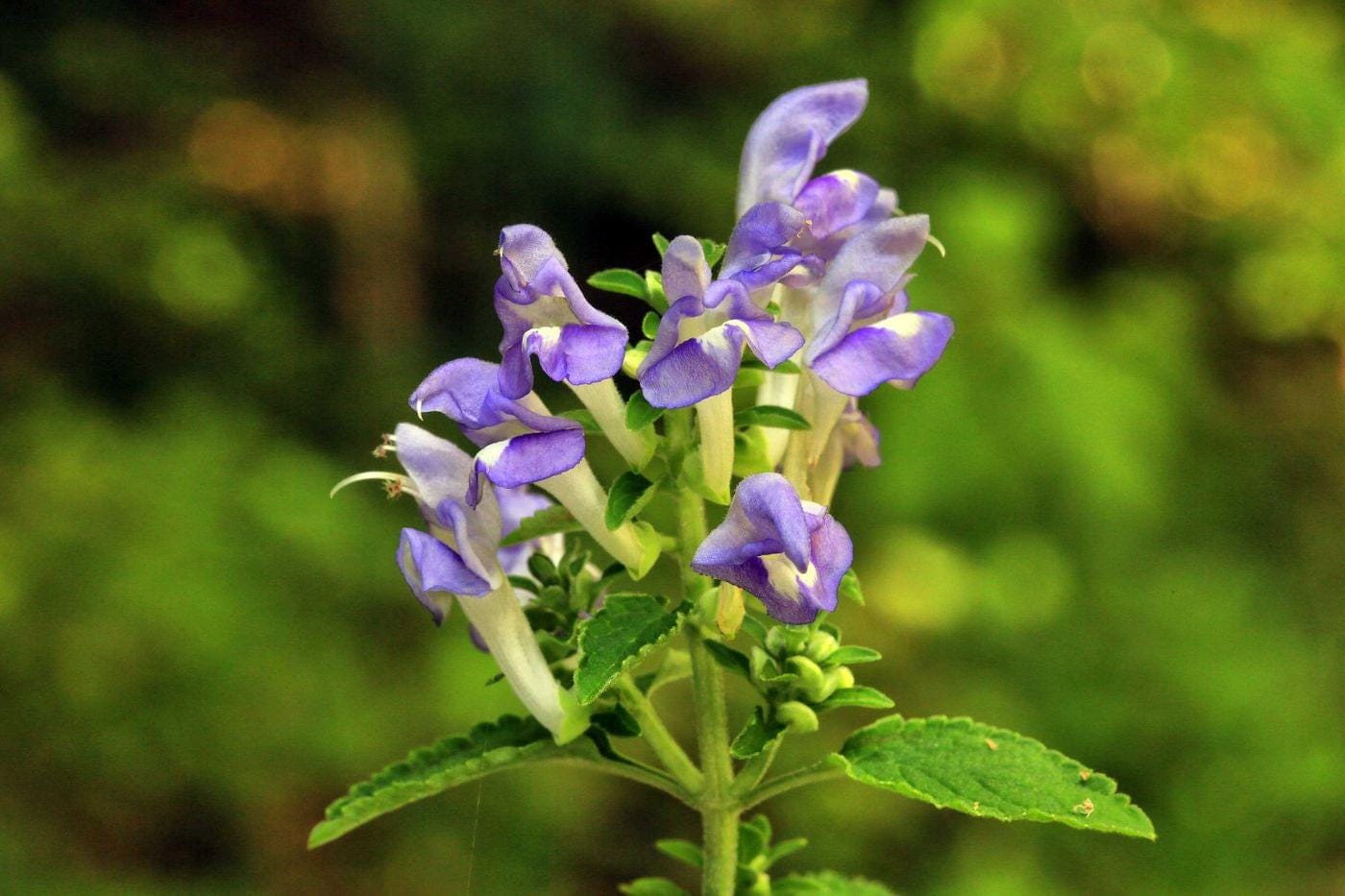Skullcap is a plant in the mint family that helps to relieve tension in the body caused by the mind. The drops of tincture under my tongue feel like soothing hands stroking my head. Over time, the medicine of this plant can ease those of us who lay awake at night with swirling thoughts. This plant was once called mad-dog herb because it was thought to cure rabies, and the extract is useful when our jaw is tense and we want to growl. This is also a wonderful ally for those like me who are sensitive to sound.
We are vulnerable when we sleep and when we are alone at night every sound can become amplified, our primal senses may be on alert; the strange banging in the radiator, a creak in the staircase, and the rattle of the wind that was a pleasant breeze during the day suddenly seems menacing. Each sound may make our nerves stand on end, trigger our fight‑or‑flight response, and cause tension. Whatever the cause, skullcap can calm the feeling of hypervigilance and extreme sensitivity to external influences that can become a pattern of response in our body. If left unchecked, the tension that is created can take on a life of its own.
Chinese skullcap (Scutellaria baicalensis) has a high level of melatonin, a hormone made by the pineal gland that regulates our sleep/wake cycles and can help reset our circadian rhythm. Melatonin aligns us with the seasons with higher levels in long nights of autumn and winter, and lower levels in the light of spring and summer. For animals like wolves, the hormone is essential in the timing of reproduction and their growing and shedding of fur. Without melatonin, they are not equipped to survive in the wild.
My in-person herbalism classes often begin by passing a mystery tea, tincture or plant around (a single, safe plant), then tuning into our bodies, listening, and journaling:
What am I feeling in my body? Is the herb bitter, sweet, salty, sour, astringent or pungent? What is the mouth-feel? Does the plant feel drying, moistening? Warming or cooling? Stimulating or sedating? Loosening or contracting? Is it helping my mind focus or do my thoughts seem more expansive?
I’m interested in what students feel and perceive when they interact with plants. The exercise is also a practice of deep listening; learning to trust our bodies and our experience.
I am always fascinated by what students write and share and it thrills me when their experiences and notes are similar. This is empirical evidence and over time, students learn to listen to subtleties and tune in when their bodies are whispering to them. Without knowing what it is, Skullcap is a plant that many have a profound reactions to. Students write and share: “I feel more focused, more calm, I think this is a nervine.”
Whenever possible we spend time with the plant in their habitat, too. Whether an herb garden, or forest edge, we get quiet and observe: Where does the plant grow? Do they prefer sun or shade? Are the leaves moist, slimy and flexible or do they crumble in my hands? Do I see pollinators? Companion plants? What might they be trying to defend themselves against? This not only helps us understand the plant and their medicine, but it also trains our attention to detail and deepens intimacy with nature.
WHERE AND HOW DOES SKULLCAP GROW?
Skullcap (Scutellaria lateriflora) is native to the eastern United States. A perennial in the mint family, Skullcap grows up to 3 feet tall and can be found in moist woodland areas throughout North America. The blue flowers usually bloom in July and are open through September
WILDCRAFTING & MEDICINE MAKING:
A mint-family plant, skullcap is easy to grow in your herb garden. But if you find a strong stand of skullcap in the wild, you can gather aboveground parts including the stems, leaves, while the plant is in flower. I mainly prepare skullcap as fresh plant tincture, soon after gathering.
MAKING TINCTURE
The best tinctures are made from fresh plant material. Tear or chop the plant material to extract as much medicine as possible (except flowers and delicate plants). Fill a glass jar 2/3-3/4 of the way to top with the plant material. You want to make sure the plant material is completely covered by the liquid. Then fill the jar to the top with 80 or 100-proof vodka, vinegar (ideally raw, organic apple cider vinegar), or the spirit of your choice. Cap the jar tightly. Label the jar with the name of the plant, the part of the plant used, the type of the spirit used, and the date. Top up the liquid level the next day. Let it sit for six weeks or more so that you have a potent medicine. Decant the tincture by carefully pouring the liquid into tinted tincture bottles and composting the plant material. Then it is ready to use. If you’re compelled to buy Skullcap tincture now, Herb Pharm is a good resource for responsibly-made tincture. Consult your local herbalist for dosage.
USE AS A TEA
Skullcap is also effective as a tea. Some students have found that the tea is slightly more sedating than the tincture and helpful to drink a half an hour or so before bedtime. I’ve found that a blend of dried skullcap and passionflower work well together. My favorite nervine blend is skullcap, passionflower and oatstraw.
Have you worked with Skullcap? If so, I’d love to hear your stories. Please share in the comment section. And if you’d like to learn more about medicinal plants, join me for an online plant walk on April 8th. Seasonal plant walks are free for ‘Weeds, Wolves & Wild Women’ supporters at the $50+ level. 🌱







